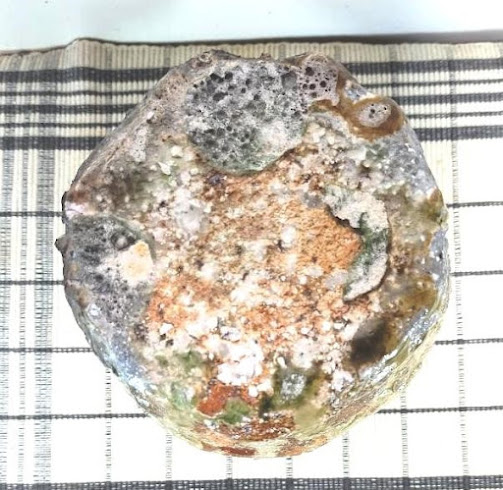261. FUJIMOTO Hide 藤本 秀, 1954- , Shigaraki uzukumaru [tsubo] 信楽蹲[壺] (Shigaraki-ware “crouching” vase)
For Fujimoto, see item no. 250.
The designation of this as a tsubo follows the usage for similar uzukumaru pots. For another example, see item no. 218,
To judge from other examples of uzukumaru pots online, the term is reserved for a style of pots made in Shigaraki. They are roughly circular in cross-section. From a broad, flat base, the walls rise outwards in a more or less straight line to the widest diameter at the high shoulders. From there, the walls curve inward rapidly to a small, short vertical neck surmounted by jutting horizontal lips with beveled edges.
Light gray clay. Fired unglazed, with heavy kiln effects--ash deposits in deep black, hi-iro (fire colors) in light red, melted ash glaze in a creamy brown, with some vitrification and bidoro green glass-like deposits and drips. Weight: 1.9 kg (4.3 lb). Height: 19 cm (7-1/2 in). Widths: rim, 8.2 cm (3-1/4 in); widest, 16.4 cm (6-1/2 in); base, 12 cm (4-3/4 in).
This sits on the flat circular base. The remnants of the four posts used to separate the piece from the kiln shelf during firing are visible on the base. The body is roughly circular but with many shallow dents and bulges. The widest point occurs at the shoulders, 11.3 cm (4-1/2 in) above the base. The walls then curve inward to the neck, which is 16 cm (6-3/8 in) above the base and 5.7 cm (2-1/4 in) in diameter. The lip juts outward above the neck, Both the lower and the upper surfaces are beveled. Two lines scratched into the clay undulate around the vase, one positioned slightly below the shoulders and one above. The lines range from 2.5 to 5 cm (1-2 in) apart. A series of X’s was inscribed within these lines. Some of the lines in the X’s rise above the upper line. This is known as the “cypress fence pattern” 檜垣文 higakimon. The interior of the piece mirrors the exterior. The surface is rough and crusted.
This was fired unglazed. One side (arbitrarily the back side) was covered with a heavy layer of ash, leaving a dark matte black surface, much pitted and very irregular. This layer is so thick that it largely obscures the undulating lines and X’s in this area. The portions of the exterior walls beside the neck on this side show some reddish-brown hi-iro. The front side, particularly the upper portions, were covered with a natural ash glazing, which ran down the front side to the base, leaving some portions uncovered and again showing hi-iro colors. The neck, rim, and mouth of the piece are also covered with natural ash glazing in the creamy brown color. Some areas of the natural ash glazing shows vitrification. Unusually the base is also encrusted with ash deposits and has one tambo no me bead of green glass-like melted ash glazing. This must have been fired near the front of the kiln and received a full blast of ash deposits and heat.
This came in a wooden box inscribed by Fujimoto in three lines: 信楽 / 蹲 / 藤本 秀 Shigaraki / uzukumaru / Fujimoto Hide (Shigaraki / crouching / Fujimoto Hide), followed by the artist’s seal stamped in red. Included in the box was a short printed biography of the artist.
I found a picture of a Muromachi-period Shigaraki "crouching" tsubo that has a similar decorative scheme of two lines running around the shoulders with a pattern of X's inscribed between them. The decoration on that piece is more regular, however, and the kiln effects are much more limited (chiefly hi-iro with some golden fly ash). See Samuel J. Lurie and Beatrice L. Chang, Fired with Passion: Contemporary Japanese Ceramics (2006), p. 110, fig. 82.
Purchased
from the Kura Monzen Gallery in Kyoto in September 2024, who received it
directly from the potter in summer 2024. This was part of an exhibit entitled Shōka
昇華
(“sublime”), or Modern Masters in English,
a show of fifteen currently active potters (invoice and shipping and customs
documents).











No comments:
Post a Comment